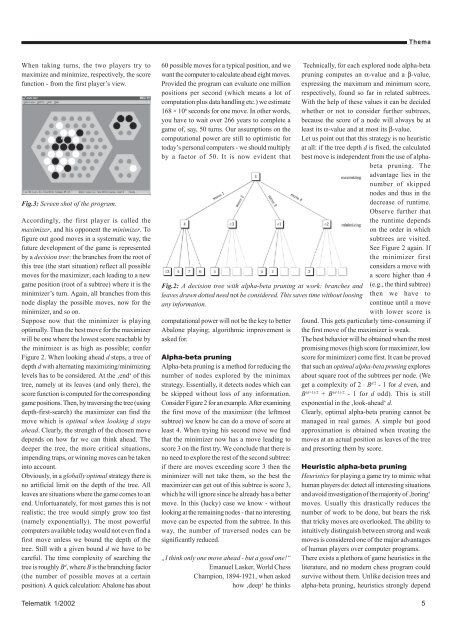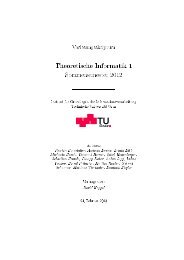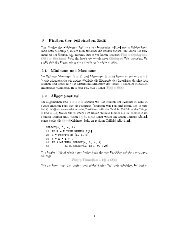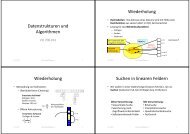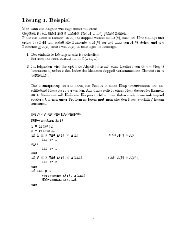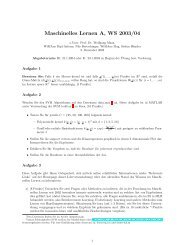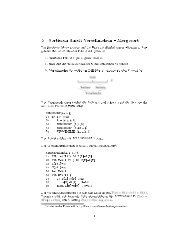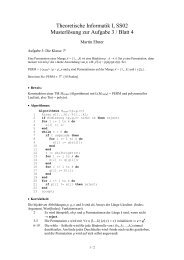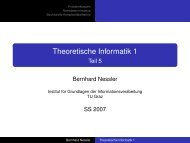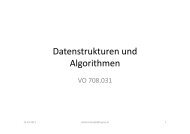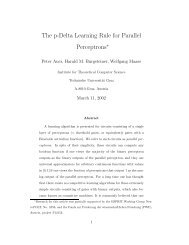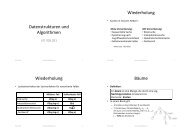Telematik 2/02 - Institut für Grundlagen der Informationsverarbeitung ...
Telematik 2/02 - Institut für Grundlagen der Informationsverarbeitung ...
Telematik 2/02 - Institut für Grundlagen der Informationsverarbeitung ...
Create successful ePaper yourself
Turn your PDF publications into a flip-book with our unique Google optimized e-Paper software.
When taking turns, the two players try to<br />
maximize and minimize, respectively, the score<br />
function - from the first player’s view.<br />
Fig.3: Screen shot of the program.<br />
Accordingly, the first player is called the<br />
maximizer, and his opponent the minimizer. To<br />
figure out good moves in a systematic way, the<br />
future development of the game is represented<br />
by a decision tree: the branches from the root of<br />
this tree (the start situation) reflect all possible<br />
moves for the maximizer, each leading to a new<br />
game position (root of a subtree) where it is the<br />
minimizer’s turn. Again, all branches from this<br />
node display the possible moves, now for the<br />
minimizer, and so on.<br />
Suppose now that the minimizer is playing<br />
optimally. Than the best move for the maximizer<br />
will be one where the lowest score reachable by<br />
the minimizer is as high as possible; confer<br />
Figure 2. When looking ahead d steps, a tree of<br />
depth d with alternating maximizing/minimizing<br />
levels has to be consi<strong>der</strong>ed. At the ‚end‘ of this<br />
tree, namely at its leaves (and only there), the<br />
score function is computed for the corresponding<br />
game positions. Then, by traversing the tree (using<br />
depth-first-search) the maximizer can find the<br />
move which is optimal when looking d steps<br />
ahead. Clearly, the strength of the chosen move<br />
depends on how far we can think ahead. The<br />
deeper the tree, the more critical situations,<br />
impending traps, or winning moves can be taken<br />
into account.<br />
Obviously, in a globally optimal strategy there is<br />
no artificial limit on the depth of the tree. All<br />
leaves are situations where the game comes to an<br />
end. Unfortuanately, for most games this is not<br />
realistic; the tree would simply grow too fast<br />
(namely exponentially). The most powerful<br />
computers available today would not even find a<br />
first move unless we bound the depth of the<br />
tree. Still with a given bound d we have to be<br />
careful. The time complexity of searching the<br />
tree is roughly B d , where B is the branching factor<br />
(the number of possible moves at a certain<br />
position). A quick calculation: Abalone has about<br />
<strong>Telematik</strong> 1/20<strong>02</strong><br />
60 possible moves for a typical position, and we<br />
want the computer to calculate ahead eight moves.<br />
Provided the program can evaluate one million<br />
positions per second (which means a lot of<br />
computation plus data handling etc.) we estimate<br />
168 × 10 6 seconds for one move. In other words,<br />
you have to wait over 266 years to complete a<br />
game of, say, 50 turns. Our assumptions on the<br />
computational power are still to optimistic for<br />
today’s personal computers - we should multiply<br />
by a factor of 50. It is now evident that<br />
Fig.2: A decision tree with alpha-beta pruning at work: branches and<br />
leaves drawn dotted need not be consi<strong>der</strong>ed. This saves time without loosing<br />
any information.<br />
computational power will not be the key to better<br />
Abalone playing; algorithmic improvement is<br />
asked for.<br />
Alpha-beta pruning<br />
Alpha-beta pruning is a method for reducing the<br />
number of nodes explored by the minimax<br />
strategy. Essentially, it detects nodes which can<br />
be skipped without loss of any information.<br />
Consi<strong>der</strong> Figure 2 for an example. After examining<br />
the first move of the maximizer (the leftmost<br />
subtree) we know he can do a move of score at<br />
least 4. When trying his second move we find<br />
that the minimizer now has a move leading to<br />
score 3 on the first try. We conclude that there is<br />
no need to explore the rest of the second subtree:<br />
if there are moves exceeding score 3 then the<br />
minimizer will not take them, so the best the<br />
maximizer can get out of this subtree is score 3,<br />
which he will ignore since he already has a better<br />
move. In this (lucky) case we know - without<br />
looking at the remaining nodes - that no interesting<br />
move can be expected from the subtree. In this<br />
way, the number of traversed nodes can be<br />
significantly reduced.<br />
„I think only one move ahead - but a good one!“<br />
Emanuel Lasker, World Chess<br />
Champion, 1894-1921, when asked<br />
how ‚deep‘ he thinks<br />
Thema<br />
Technically, for each explored node alpha-beta<br />
pruning computes an α-value and a β-value,<br />
expressing the maximum and minimum score,<br />
respectively, found so far in related subtrees.<br />
With the help of these values it can be decided<br />
whether or not to consi<strong>der</strong> further subtrees,<br />
because the score of a node will always be at<br />
least its α-value and at most its β-value.<br />
Let us point out that this strategy is no heuristic<br />
at all: if the tree depth d is fixed, the calculated<br />
best move is independent from the use of alphabeta<br />
pruning. The<br />
advantage lies in the<br />
number of skipped<br />
nodes and thus in the<br />
decrease of runtime.<br />
Observe further that<br />
the runtime depends<br />
on the or<strong>der</strong> in which<br />
subtrees are visited.<br />
See Figure 2 again. If<br />
the minimizer first<br />
consi<strong>der</strong>s a move with<br />
a score higher than 4<br />
(e.g., the third subtree)<br />
then we have to<br />
continue until a move<br />
with lower score is<br />
found. This gets particularly time-consuming if<br />
the first move of the maximizer is weak.<br />
The best behavior will be obtained when the most<br />
promising moves (high score for maximizer, low<br />
score for minimizer) come first. It can be proved<br />
that such an optimal alpha-beta pruning explores<br />
about square root of the subtrees per node. (We<br />
get a complexity of 2 ⋅ B d/2 - 1 for d even, and<br />
B (d+1)/2 + B (d-1)/2 - 1 for d odd). This is still<br />
exponential in the ‚look-ahead‘ d.<br />
Clearly, optimal alpha-beta pruning cannot be<br />
managed in real games. A simple but good<br />
approximation is obtained when treating the<br />
moves at an actual position as leaves of the tree<br />
and presorting them by score.<br />
Heuristic alpha-beta pruning<br />
Heuristics for playing a game try to mimic what<br />
human players do: detect all interesting situations<br />
and avoid investigation of the majority of ‚boring‘<br />
moves. Usually this drastically reduces the<br />
number of work to be done, but bears the risk<br />
that tricky moves are overlooked. The ability to<br />
intuitively distinguish between strong and weak<br />
moves is consi<strong>der</strong>ed one of the major advantages<br />
of human players over computer programs.<br />
There exists a plethora of game heuristics in the<br />
literature, and no mo<strong>der</strong>n chess program could<br />
survive without them. Unlike decision trees and<br />
alpha-beta pruning, heuristics strongly depend<br />
5


